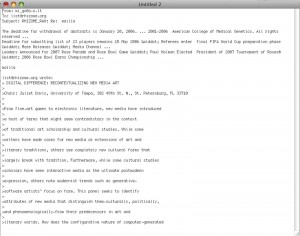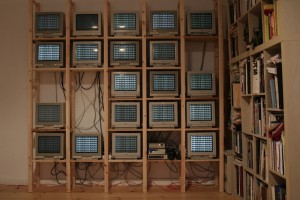
Gapševičius Mindaugas
 Carpet/?s, 2006, http://triple-double-u.com/carpet/?s
Carpet/?s, 2006, http://triple-double-u.com/carpet/?s
carpet/?s and t-shirt/?s is an internet based project that allows you to try preprogrammed machines for generating patterns made out of ascii (American Standart Code for Information Interchange). It runs on a php application where internet resources are used as yarn to make ascii cloths. The user only has to do one click and a machine does the rest. The program generates output, which is always unique. It is based on the time when the surfer goes to a web site. The time in a form of hh:mm:ss is then used as a keyword for the results taken from a search engine. The program downloads the contents of given results, rejects html tags and white spaces and puts all content into a image-like pattern. The produced image can be printed out on a t-shirt or weaved in a factory and then shipped to the addressee. The process of weaving the rug usually takes a month after the arival of payment. The rug is weaved with a natural wool and/or linen. The yarn left on the facing side of the rug is 1cm or longer if there is a special request. The ordered t-shirt is shipped within a week.
 Mailia, 2006, http://triple-double-u.com/mailia
Mailia, 2006, http://triple-double-u.com/mailia
At present the rapidly expanding Semantic Web analyzes digital information in order to distinguish valuable content from digital trash. As well modern day search engines give more and more precise results of searched information yet how far will this artificial intelligence go? Will we eventually be able to leave it to machines to perform automated tasks such as creating images or writing texts?
For example digital information that is delivered via email increases daily if not hourly which in turn takes more and more time to answer and sort. The email answering machine provides a solution for this as it will write the answer emails using material available online.
Mailia analyzes emails coming to ones mailbox and simply replies to them. Forget automated standard ‘Out of Office’ replies, Mailia is as intelligent as software like Eliza and as flexible as open source products. The email answering machine works in the following way: it grabs an incoming message, analyzes it, sends requests to the Google search engine, then picks up given results, sorts them, and outputs the information into an email form which is sent back to the sender. If answers are publicly saved, search engines will index the answers again and utilize these as output for other similar replies. Ironic as this statement may seem – ‘Why not let the machines live their own lives’.
Mailia is free software released under the GNU General Public License.
 Bookshelf, 2006, http://triple-double-u.com/bookshelf
Bookshelf, 2006, http://triple-double-u.com/bookshelf
Rapid flow of letters and numbers on the monitors has nothing to do with chaos theory which can cause big disruptions in our world. It has also nothing to do with hacker’s world as one would like to say. Monitors placed on a wall shelf become a contemporary bookshelf containing in itself endless digitized textual and visual material. The Bookshelf represents a network traffic translated into descriptive form, so the unseen side of “networking” would be understandable or at least readable. In technical terms the flow of letters and numbers on the monitors would sound like ‘tcpdump’, a common computer network debugging tool.
The Bookshelf was exhibited in various shapes and contexts. A Memex Wall installation, conceptualized in cooperation with superfactory.biz, was shown within a context of a “memory extender” game, the term of which was used to call a proto hypertext computer system influencing the development of subsequential hypertext and intellectual augmenting computer systems.
Mindaugas Gapševičius (born 1974) lives in Berlin and Vilnius. His work explores the impact of non-human actors on human creativity and the impact of humans on the umwelt. He has completed MA studies at the Vilnius Academy of Arts in 1999 and received a Master of Philosophy degree from the Goldsmiths University of London. He is a creative fellow at the Bauhaus University in Weimar since 2015. Gapševičius was one of the initiators and founders of Institutio Media, the first Lithuanian media art platform (1998). Along with colleagues from the TOP association, he initiated the first TOP community biolaboratory in Berlin (2016). In 2019 he established Alt lab, a laboratory for non-disciplinary research in Vilnius.
Gapševičius’s works have been shown at the Ars Electronica festival in Linz (2019, 2020, 2021), the Lithuanian National Gallery of Art (2019, 2021), MO Museum in Vilnius (2019), and Piksel festival in Bergen (2018, 2021).
Source: Personal website
